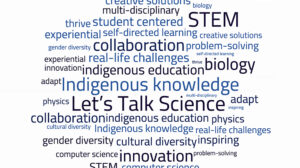There are several disturbing and persistent trends in our system affecting our most vulnerable students. Trends that clearly show that lack of literacy isn’t simply a function of whether someone is “academic” enough to succeed, but rather, a function of their ability to survive the education system from the margins.
Minor (2020) calls educators to address the intersectionality among all groups subject to oppression and to be imaginative to find solutions for sustained institutional action and change. He argues it is necessary we plan for equity in everything we do. We should name oppressive factors and advocate for intentional redistribution of resources to ensure no one is left out. He argues it is essential to “be more attentive to school-based outcomes, grow and develop our understanding of what drives those outcomes, and understand how systems impact curriculum, pedagogy, school and classroom culture”.
As educators, this is our responsibility.
As a curriculum writer, teacher, and scholar, I would like to share key learnings of my dissertation:
A Case Study: Revising and Humanizing the High School English Language Arts Program in Prince Edward Island, Canada
Relationship Between Socioeconomic Status and Literacy
Frontier College’s (2019) National Report, Essential Skills as a Poverty Reduction Strategy, indicates that some of the most vulnerable populations in Canada are women, newcomers to Canada, Indigenous peoples, persons with disabilities, the rural poor, unattached individuals and seniors. As a result, there are specific barriers within these populations that people face which impact their level of literacy and socioeconomic status (p. 14-15). Harriett McLachlan states that “when someone is struggling to pay their rent, to pay their hydro electric bills, when they’re focused on the basic elements of their wellbeing and health and living circumstances, there’s not much energy left over for doing anything beyond that” (p. 20).
Tilleczek (2011), argues “socioeconomic gradients have been well mapped out in Canada and they are sticking with us. But it remains to be seen how growing income inequality in Canadian society will become further complicit and complicated in our embarrassing and dishonorable treatment of poor kids in school”. Time and time again, research has shown an association between poverty and level of literacy (Frontier College, 2019; Follwell & Andrew, 2021; Gilisic & Favaro, 2017; Hamlin & Cameron, 2015; Krahn & Taylor, 2000; and Statistics Canada 2005).
The Truth About Traditional Academic Streaming
Streaming in Canadian English language arts means positioning students on pathways for university, college, apprenticeship or work. While this may not seem disturbing on the surface, I assure you, a deep dive into the trends of who is positioned where is concerning. Follwell & Andrew (2021) note that
streaming and its disproportionate impacts on people from racialized and low- income communities and those with special needs has been a point of contention for decades. Governments have engaged the calls for provincial de-streaming to varying degrees, although there has been no successfully implemented and sustained systemic reform.
“The early vocational education was driven by a philosophy of fitting people to their probable destinies”, says Jim Stone, director of the National Research Center for Career and Technical Education. “Kids from poor families were tracked off into becoming worker bees. Others were tracked off to go to universities and be the intelligentsia” (Hanford, 2014).
This type of thinking limits student potential and funnels marginalized students to nonacademic programs. These streams promote labeling, stigmatize children, and foster generational poverty and oppression. Perhaps one of the most disturbing factors is that research against traditional streaming has existed for decades with little done to change negative outcomes for students. Gilisic & Favaro (2017) share the negative outcomes of streaming in Canada and the United States:
- A correlation between demographic factors (low socioeconomic status, race, ethnicity, gender) and placement in a low academic stream,
- that streaming reproduces the pre-existing social and economic disparities in society,
- that streaming often creates low expectations and aspirations among lower streamed students,
- that streaming is often associated with a reduction in quality of instruction and learning environment in lower streamed classes,
- that streaming leads to low engagement, low motivation, and dissatisfaction of students in lower streamed classes,
- that streaming is associated with an increased risk of dropping out of school, and
- that long-term streaming has the potential for reduced social mobility, occupational opportunity, and lifetime income
(Boaler, 2005; Boaler, William, & Brown, 2000; Canadian Education Association, 2010; Clanfield, 2014; Curtis, Livingstone, & Smaller, 1992; Duggan, 1995; Fielder, Lange & Winebrenner, 2002; Gamoran & Mare, 1989; Holm, Jaeger, Karlson, & Reimer, 2013; Krahn & Taylor, 2007; Hallinan, 1994; Oaks, 1985; Parekh, Killoran, & Crawford, 2011; Werblow, Ulrick, & Duesbery, 2013).
When addressing streaming, understanding the achievement gap between students in nonacademic and academic programming is critical. A meaningful solution will ensure that all students have the literacy skills they need to survive the realities of life after high school. There have been a number of options presented to solve this problem.
- We can stop streaming. BC is an example of a province that has stopped streaming in English language arts. Understanding that achievement gaps are present, it will be important to provide the resources, support and training teachers will need. Class size should also be a consideration due to the unique teaching and assessment demands English teachers experience. To truly remove the negative factors from streaming, we should see the achievement gap narrow between mainstream assessment data when compared to data from marginalized groups such as Indigenous students and students with special needs.
- We can delay streaming. Ontario has recently delayed streaming until grade 10, the most common grade to begin streaming in Canada. New Brunswick and Nova Scotia have delayed streaming until grade 11. It will be important to understand what this delay will do and how it will impact the literacy levels of the students who are streamed in later grades. The cause of the literacy gap and meaningful solutions will still need to be addressed to ensure our most vulnerable students can be successful.
- We can bridge students from nonacademic programs to academic English. Prince Edward Island’s adoption of the Bridging Program replaced nonacademic English programs. Of the first provincial cohort, 36% of students transitioned from the Bridging Program to academic English by graduation. 90% of students who remained in the Bridging Program achieved essential literacy skills as demonstrated in common assessments. Teachers engaged in moderated marking with staff from the Dept of Education.
This program came with resources, training, and a desire to create the structural conditions for students to become successful. The academic program was also revised giving students and teachers more agency and choice. Lean, flexible curriculum plans combined with rich resources and training was essential for all grades. As part of my research, I have made recommendations to the Prince Edward Island Dept of Education. I encouraged them to use the Bridging Program to further destream high school English language arts in Prince Edward Island. I have also suggested that grade level reading and writing achievement should be considered foundational for earlier grades (MacLaren 2023).
Evidence Based English Language Arts Programs
A lot of changes have taken place in English language arts programs over the years. While content acquisition of the traditional literary canon has historically been viewed as the most rigorous curriculum for high school English, we know better today. English language arts classrooms that aim for high expectations and outcomes for all students will:
- Promote voluminous, pleasurable reading with a focus on independent and choice reading (Shaffer, Curser, McKoy, Shults (2019). For example, 25% whole class texts, 25% shared texts, 50% independent texts.
- Develop student’s personal identity as a speaker, reader, and writer.
- Provide rich resources such as classroom libraries.
- Recognize the role of background knowledge in reading comprehension.
- Focus on process and skill development, not content acquisition.
- Provide representation for all students. All students need to see themselves in the curriculum.
- Promote student’s independent problem solving, critical thinking, and decision-making skills.
- Utilize technology to empower students.
- Address individual needs through whole class, small group, and conferencing (1:1 teaching).
- Utilize learning experiences that promote equity, inclusion, understanding and empathy.
- Promote collaboration among English language arts teachers as well as trained teacher librarians.
Things to Consider When Supporting Students
Tilleczek et al. (2010) note key considerations with respect to transitions to secondary school. “Students also experience (or fear) structural problems. They express concern about size and layout of secondary schools, the timetable, complicated school schedules, having more homework, and having multiple teachers. Poor and immigrant youth in particular find the transition more difficult than they expect it to be” (p. 69). As a result, we can pay attention to transitions, plan for them, and develop soft landings (e.g, study class or a resource class taken the same semester as English). Other considerations include:
- Assign your most skilled and experienced teachers to the courses requiring the most skill- and support them! Balance workload to avoid burn out.
- Avoid using an academic intervention or response for a social/emotional/economic need. For example, don’t immediately encourage a student to drop to applied English from academic because they work a lot. Consider building a study block into their schedule or offering them a quiet space to work after school. Accessing school supports such as the youth worker or guidance counselor may also help.
- Access school and community mentorship for students.
- Position students to take advantage of opportunities to bridge out to academic courses. For example, if a student takes applied English first semester, they could pivot to academic the second. While most policy doesn’t prevent this transition, it is often a rare occurrence in schools. Students will need to be supported academically and socially in this transition.
- Focus on a school climate that has high expectations for all students. All students can make a year’s worth of growth each school year.
- Create opportunities for professional development and teacher collaboration.
By: Dr. Kendra MacLaren
For full references and more information on Kendra’s research, see https://islandscholar.ca/islandora/object/ir:25355










